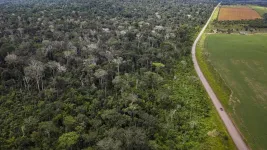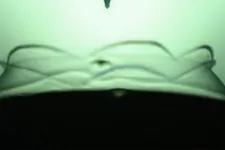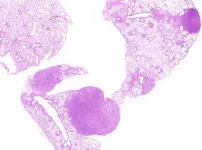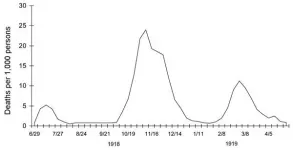(Press-News.org) A new approach to analyse satellite measurements of Earth's cloud cover reveals that clouds are very likely to enhance global heating.
The research, by scientists at Imperial College London and the University of East Anglia, is the strongest evidence yet that clouds will amplify global heating over the long term, further exacerbating climate change.
The results, published today in Proceedings of the National Academy of Sciences, also suggest that at double atmospheric carbon dioxide (CO2) concentrations above pre-industrial levels, the climate is unlikely to warm below 2°C, and is more likely on average to warm more than 3°C.
Pre-industrial CO2 levels were around 280 ppm (parts per million), but current levels are approaching 420 ppm, and could approach double the pre-industrial amount by mid-century if significant emissions cuts are not made. The amount of climate warming predicted from a doubling of pre-industrial CO2 levels is known as the 'climate sensitivity' - a measure of how strongly our climate will react to such a change.
The largest uncertainty in climate sensitivity predictions is the influence of clouds, and how they may change in the future. This is because clouds, depending on properties such as their density and height in the atmosphere, can either enhance or dampen warming.
Co-author Dr Paulo Ceppi, from the Grantham Institute - Climate Change and the Environment at Imperial, said: "The value of the climate sensitivity is highly uncertain, and this translates into uncertainty in future global warming projections and in the remaining 'carbon budget' - how much we can emit before we reach common targets of 1.5°C or 2°C of global warming.
"There is therefore a critical need to more accurately quantify how clouds will affect future global warming. Our results will mean we are more confident in climate projections and we can get a clearer picture of the severity of future climate change. This should help us know our limits - and take action to stay within them."
Low clouds tend to have a cooling effect, as they block the sun from reaching the ground. High clouds, however, have a warming effect, as while they let solar energy reach the ground, the energy emitted back from the Earth is different. This energy can be trapped by the clouds, enhancing the greenhouse effect. Therefore, the type and amount of cloud a warming world will produce impacts further warming potential.
Inspired by ideas from the artificial intelligence community, the researchers developed a new method to quantify relationships between state-of-the-art global satellite observations of clouds, and the associated temperature, humidity and wind conditions. From these observed relationships, they were then able to better constrain how clouds will change as the Earth warms.
They found it was very likely (more than 97.5% probability) that clouds will amplify global heating, by both reflecting less solar radiation and enhancing the greenhouse effect. These results also suggest that a doubling of CO2 concentrations will lead to around 3.2°C of warming. This is the highest confidence of any study so far, and is based on data from global observations, rather than local regions or specific cloud types.
Co-author Dr Peer Nowack, from the School of Environmental Sciences and Climatic Research Unit at the University of East Anglia and Imperial's Grantham Institute and Data Science Institute, said: "Over the last few years, there's been a growing amount of evidence that clouds probably have an amplifying effect on global warming. However, our new approach allowed us for the first time to derive a global value for this feedback effect using only the highest quality satellite data as our preferred line of evidence.
"Our paper makes a major step towards narrowing the most important uncertainty factor in climate sensitivity projections. As such, our work also highlights a new pathway in which machine learning methods can help us constrain the key remaining uncertainty factors in climate science."
INFORMATION:
Throughout history, people of different cultures and stages of evolution have found ways to adapt, with varying success, to the gradual warming of the environment they live in. But can the past inform the future, now that climate change is happening faster than ever before?
Yes, say an international team of anthropologists, geographers and earth scientists in Canada, the U.S. and France led by Université de Montréal anthropologist Ariane Burke.
In a paper published today in the Proceedings of the National Academy of Sciences, Professor Burke and her colleagues ...
A major drought and forest fires in the Amazon rainforest killed billions of trees and plants and turned one of the world's largest carbon sinks into one of its biggest polluters.
Triggered by the 2015-16 El Niño, extreme drought and associated mega-wildfires caused the death of around 2.5 billion trees and plants and emitted 495 million tonnes of CO2 from an area that makes up just 1.2 per cent of the entire Brazilian Amazon rainforest, and 1 per cent of the whole biome.
The stark findings, discovered by an international team of scientists working for more than eight years on a long-term study in the Amazon before, during and after the El Niño, have significant implications for global efforts to control the atmospheric ...
The oil industry, pharmaceutical companies and bioreactor manufacturers all face one common enemy: bubbles. Bubbles can form during the manufacturing or transport of various liquids, and their formation and rupture can cause significant issues in product quality.
Inspired by these issues and the puzzling physics behind bubbles, an international scientific collaboration was born. Stanford University chemical engineer Gerald Fuller along with his PhD students Aadithya Kannan and Vinny Chandran Suja, as well as visiting PhD student Daniele Tammaro from the University of Naples, teamed up to study how different kinds of bubbles pop.
The researchers were particularly interested in bubbles with proteins embedded on their surfaces, which is a common occurrence in the pharmaceutical industry ...
New research has found marine seismic surveys used in oil and gas exploration are not impacting the abundance or behaviour of commercially valuable fishes in the tropical shelf environment in north-western Australia.
The research is the first of its kind to use dedicated seismic vessels to measure the impacts of the survey's noise in an ocean environment, with the eight-month experiment conducted within a 2500 square kilometre fishery management zone near the Pilbara coast.
It involved using multiple acoustic sensors, tagging 387 red emperor fish and deploying more than ...
KRAS was one of the first oncogenes to be identified, a few decades ago. It is among the most common drivers of cancer and its mutations can be detected in around 25 per cent of human tumours. The development of KRAS inhibitors is, thus, an extremely active line of research. Effective results have been elusive so far, though - no KRAS inhibitor had been available until a month ago, when the FDA granted approval to Sotorasib.
KRAS encodes two gene products, KRAS4A and KRAS4B, whose levels can vary across organs and embryonic stages. When KRAS mutates, both variants, or isoforms, are activated. Though, some studies have focussed on approaches to target only KRAS4B, since it usually found to be expressed at ...
Evidence shows that early detection and treatment of cancer can significantly improve health outcomes, however women in Mississippi, particularly in underserved populations, experience the worst health outcomes for cervical, breast, and oropharyngeal cancer. ...
From the onset of the COVID-19 pandemic there have been countless comparisons to the 1918 influenza pandemic in terms of overall medical impact. Many of the comparisons addressed overall cases which, given the lack of a confirmatory lab test in 1918 and no meaningful case definitions for both pandemics, make such comparisons patently invalid. Overall mortality comparisons, although methodologically flawed as well, do offer a reasonably comparative outcome measure and offers a greater degree of validity. This measure is further enhanced when adjusted for population and average life years lost (see accompanying table for mortality comparisons ...
Researchers at Michigan Medicine have discovered yet another functional autoantibody in COVID-19 patients that contributes to the disease's development and the "firestorm" of blood clots and inflammation it induces.
A growing body of studies suggests COVID-19 emulates many aspects of systemic autoimmune disorders, including the release of a flurry of overactive immune cells that produce toxic webs of proteins and DNA called neutrophil extracellular traps, or NETs.
For this study, the team analyzed serum from over 300 hospitalized COVID patients, searching for a novel autoantibody that shields the toxic NETs from being destroyed and produces a lasting ...
The link between on-road traffic and air pollution is well-known, as are the negative health impacts of pollution exposure. However, the many factors that may influence commuters' exposure to pollutants - such as frequency, time, and duration of commute - and the overall impact of commuting remains a matter of on-going scientific discovery.
Dr. Jenna Krall, assistant professor at the George Mason University College of Health and Human Services, is using statistical methods to better understand exposure to air pollution. Krall studies how commuting patterns impact exposure to fine particulate matter ...
EAST LANSING, Mich. - Tens of millions of patients around the world suffer from persistent and potentially life-threatening wounds. These chronic wounds, which are also a leading cause of amputation, have treatments, but the cost of existing wound dressings can prevent them from reaching people in need.
Now, a Michigan State University researcher is leading an international team of scientists to develop a low-cost, practical biopolymer dressing that helps heal these wounds.
"The existing efficient technologies are far too expensive for most health care systems, ...




